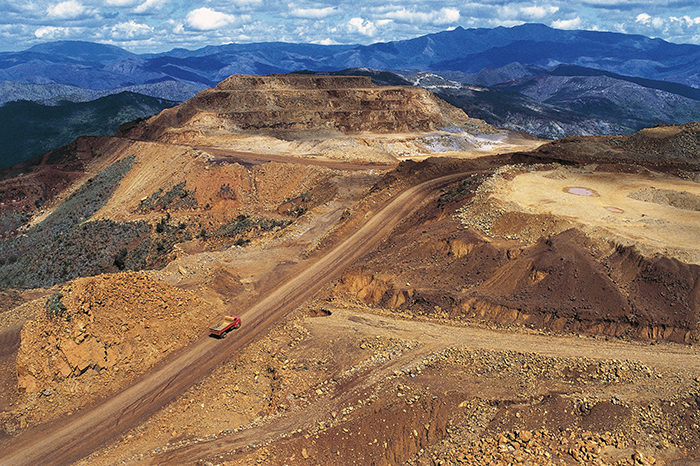Interviews / Energy and Raw Materials
21 May 2024
New Caledonia and the Geopolitics of Critical Metals: Towards a Disruption of the Nickel Market?

A critical metal at the heart of the current digital and ecological transition, nickel prices are experiencing significant instability. Amid major political unrest in New Caledonia, the archipelago accounts for 5.6% of global nickel production, contributing 20% to its GDP and 90% of its exports. Could this explain the current downturn in the market? How can the current situation and global mining production be assessed? What is the state of nickel geopolitics?
Insights from Emmanuel Hache, Research Director at IRIS and specialist in energy foresight and the economics of natural resources (energy and metals).
Are Recent Events in New Caledonia Linked to the Current Trends in the Nickel Market?
The global nickel industry is paradoxically highly fragile despite its growing strategic importance. Nickel is classified as a critical metal for the energy transition, alongside copper and lithium. While nickel is currently used primarily in alloys and stainless steel production, its role in low-carbon technologies—particularly batteries—is expanding. Nickel is a key component of lithium-ion or NMC (nickel, manganese, cobalt) batteries.
Projections for 2040 indicate that nickel demand could increase by 75%, rising from the current 3.6 million tonnes to over 6.2 million tonnes, with low-carbon technologies accounting for more than 50% of usage by that time. Such market forecasts would typically suggest price stabilization or significant increases. However, nickel prices have been marked by persistent volatility.
At the London Metal Exchange (LME), one of the world’s leading markets for nickel, prices rose nearly 40% during 2021 and 2022. This growth was followed by a 17% decline in 2023 on an annual average basis. Prices deteriorated throughout 2023, falling from $28,000 per tonne in January 2023 to $16,100 per tonne in January 2024—a sharp 43% decrease.
Since February 2024, prices have recovered slightly, reaching approximately $18,000 per tonne. This recovery is attributed to sanctions imposed by the United States and the United Kingdom on metals originating from Russia, which accounts for 5.5% of global nickel production. Despite this modest rebound, current prices remain far below historical highs. For reference, nickel prices peaked at over $52,000 per tonne in May 2007, prior to the global financial crisis—nearly three times today’s levels.
The volatility of nickel prices, coupled with the strategic role of the metal in the energy transition, underscores the importance of stabilizing global supply chains and market dynamics. Events in New Caledonia, which produces 5.6% of global nickel, may therefore have a tangible impact on market trends, particularly given the region’s political instability and its centrality to nickel exports.
The context is particularly favourable with the low-carbon transition underway. How, then, can the current slump in nickel prices be explained?
The price slump is largely due to the situation observed among global producers. In 2023, nearly 3.6 million tonnes of nickel ore were extracted from the world’s major mines, marking a 10% increase compared to the previous year. Production by the world’s leading producer rose by nearly 14% last year, accelerating the price decline. Indonesia now accounts for 50% of global nickel mining production, up from less than 30% in 2019. It is followed by the Philippines (11% of global production), New Caledonia (5.6%), Russia (5.5%), and Canada (5%). According to the International Energy Agency (IEA), by 2030, the group consisting of Indonesia, the Philippines, and New Caledonia could represent 75% of global mining production.
In this context, New Caledonia’s nickel industry faces intense competition. Despite holding 5.6% of the world’s reserves and having increased production in recent years, New Caledonia is bearing the full brunt of the policies pursued by the world’s largest producer (ramped-up production and vertical integration), as well as rising energy costs since 2022. Moreover, most companies operating in the region are heavily indebted and have underinvested in recent years.
The French group Eramet and its subsidiary Société Le Nickel (SLN), the region’s largest employer, have reported declines in both production and sales. Other plants in the archipelago face even greater challenges: Koniambo Nickel SAS (KNS) has been idled following the exit of Glencore, despite significant support from the French government, and the Prony plant is also heavily indebted.
Nickel, however, remains a significant opportunity for the archipelago. The sector accounts for 20 to 25% of private-sector jobs and directly and indirectly contributes around 20% of the local economy’s GDP.
The nickel crisis in New Caledonia reflects a new form of the resource curse and the lack of diversification in the archipelago’s activities. The heavy dependence on nickel, which represents 90% of the region’s exports, is a blessing when prices are high but becomes a major challenge when prices fall.
Is There a New Resource Curse Linked to the Low-Carbon Transition?
The possession of natural resources has historically been seen as a source of wealth and power for economies. Raw materials laid the foundation for the United Kingdom’s dominance in the 19th century and the United States’ in the 20th century, with various global conflicts underscoring their strategic importance. Today, China’s positioning in the refining of metals critical to the low-carbon transition reflects this historical trend.
However, for some resource-producing countries whose role is primarily upstream in the mining supply chain, owning raw materials is not necessarily a guarantee of development. The concept of Dutch Disease emerged in 1977 in an article by The Economist, describing the Dutch economy following the discovery of gas fields in 1959 and their exploitation a decade later. Dutch Disease can be considered an economic component of the broader concept of the “resource curse,” developed in the early 1990s.
With the demands created by the low-carbon transition, the question arises whether a new resource curse could emerge for the ecological transition. We are living in a decade of uncertainties: uncertainties about the speed of deployment of low-carbon technologies, geopolitical uncertainties due to ongoing conflicts, and significant economic uncertainties with the risk of economic fragmentation. In this context, investment visibility is limited, and assessing future needs remains particularly challenging.
Resource-producing countries are now tempted to form cartels to try to control prices. The BRICS (Brazil, Russia, India, China, and South Africa) expanded to BRICS+ in January 2024 with the inclusion of Saudi Arabia, Iran, the United Arab Emirates (UAE), Egypt, and Ethiopia. This group now holds a dominant position in the production and global reserves of critical metals such as platinum group metals, rare earth elements, and copper.
In addition to their abundant resources, the group’s dominance is reinforced by a shared policy of restricting exports of strategic metals. The inherently cyclical nature of commodity markets exacerbates global disruptions, as they are the foundation of the global economy and the driving force behind current ecological and digital transitions.

